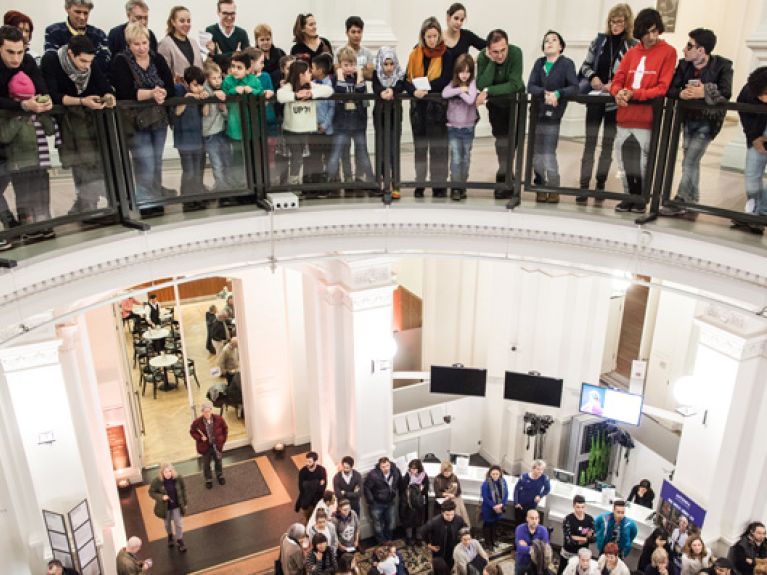Young people and the “British view” of Germany
At the Martin-Gropius-Bau in Berlin schoolchildren can see an exhibition from the British Museum. It recounts 600 years of German history and identity from a British viewpoint.

There is a very large display cabinet containing one very small item. Niklas is standing in front of it, puzzled. What is it? It looks like an egg, is made of metal, whitewashed and has holes like an oversized salt cellar. The 14-year-old schoolboy from the Alfred Nobel School in Berlin reads the sign – and discovers that the object in the case is a hand grenade. Directly after the Second World War, the Ata company refashioned into a washing powder dispenser.
The exhibition “The British View: Germany – Memories of a Nation” is in fact a view looking back, one infused with the British sense of humour. It was Neil MacGregor, former Director of the British Museum, and now the first head of Berlin’s Humboldt Forum who organized the show – really for audiences in London, where it was exhibited in 2014-5. And the recycled hand grenade is a symbol of the buzz of activity the inhabitants brought to bear in clearing up post-War Germany.
National Socialism is not one of the focuses
Two rooms in the exhibition are devoted to the Second World War, the Cold War and the time when the Berlin Wall came down. However, most of the approximately 200 exhibits deal with Germany’s crafts trades, its economic achievements, its art and its culture. This itself is surprising and Susanne Rockweiler, Deputy Director of the Martin-Gropius-Bau, attributes it to the British perspective, commenting “a curator from Germany would have made National Socialism one of the focal themes.”
This is also one of the focuses for Alina and Belinda from Grade 9 and 10 respectively at the Heinrich von Stephan Gemeinschaftsschule in Berlin. On a toured led by members of the museum’s education staff, they are exploring the rooms along with around 100 other schoolchildren, choosing specific objects to concentrate on and investigating the associated history. The two girls have selected the cast-iron entrance from the Buchenwald concentration camp. “Jedem das Seine” (each to his own) is written on it in red letters. Alina and Belinda talk about the criminal history of the camp to which people from all over Europe were deported and where more than 56,000 of them perished. “This entrance gate represents the atrocities committed during the Second World War,” explains Belinda and in Alina’s opinion they are very much a part of Germany today.
Many languages, many different perspectives
In the next room two other girls are shaking their heads. Leonore and Melissa are standing in front of a blue-grey VW Beetle. From the British perspective this car epitomizes the Germans as successful car manufacturers and enthusiastic motorists. Leonore shrugs her shoulders – a Mercedes as a symbol of the Germans, now that is something she would have understood. But this particular vehicle is no longer part of her everyday life.
The schoolchildren’s investigation of German history from a British viewpoint at this exhibition funded by the Federal Government Commissioner for Culture and the Media has a wonderful lightness to it. For many of the children taking part in this education programme with their teachers this is the first time that they have looked into their own history in such depth – their different viewpoints, languages and family backgrounds reflecting the diversity of European perspectives highlighted by the exhibition.
One good example of this is Alessia who is growing up in a bilingual environment; her parents come from Italy. At the exhibition Alessia is fascinated by the sparkling pearls in a monstrance and she researches into their function for Catholics. She already knew a little bit about them; she is a Catholic herself. And she is also aware that the Christian faith is part of Germany, as are other religions. However, she does not buy into the view expressed by the British exhibition organizers that parading through the streets at Corpus Christi carrying monstrances is ‘typically German’. She says “There are far more of them in Italy!”

